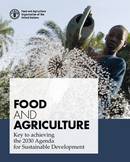Food and agriculture: key to achieving the 2030 Agenda for Sustainable Development
 Our planet faces multiple and complex challenges in the 21st century. The new 2030 Agenda for Sustainable Development commits the international community to act together to surmount them and transform our world for today’s and future generations. On 25 September 2015, the 193 Member States of the United Nations adopted the Sustainable Development Goals (SDGs), a set of 17 aspirational objectives with 169 targets expected to guide actions of governments, international agencies, civil society and other institutions over the next 15 years (2016- 2030). Succeeding the Millennium Development Goals (MDGs), the ambitious 2030 Agenda is a global vision for people, for the planet and for long-term prosperity. It charts a plan for the future – shifting the world onto a sustainable and resilient course and leading to transformation in standards of living and to a transition to more inclusive, dynamic and sustainable pathways to development. The 17 SDGs aim at ending poverty and hunger while restoring and sustainably managing natural resources. They integrate the three dimensions of sustainable development – economic, social and environmental – with closely interwoven targets. The SDGs are indivisible – no one goal is separate from the others, and all call for comprehensive and participatory approaches. And they are universal – the 2030 Agenda is as relevant to developed as it is to developing nations.
Our planet faces multiple and complex challenges in the 21st century. The new 2030 Agenda for Sustainable Development commits the international community to act together to surmount them and transform our world for today’s and future generations. On 25 September 2015, the 193 Member States of the United Nations adopted the Sustainable Development Goals (SDGs), a set of 17 aspirational objectives with 169 targets expected to guide actions of governments, international agencies, civil society and other institutions over the next 15 years (2016- 2030). Succeeding the Millennium Development Goals (MDGs), the ambitious 2030 Agenda is a global vision for people, for the planet and for long-term prosperity. It charts a plan for the future – shifting the world onto a sustainable and resilient course and leading to transformation in standards of living and to a transition to more inclusive, dynamic and sustainable pathways to development. The 17 SDGs aim at ending poverty and hunger while restoring and sustainably managing natural resources. They integrate the three dimensions of sustainable development – economic, social and environmental – with closely interwoven targets. The SDGs are indivisible – no one goal is separate from the others, and all call for comprehensive and participatory approaches. And they are universal – the 2030 Agenda is as relevant to developed as it is to developing nations.
Related Content
- Water strategy 2021 – 2025: towards a water secure Africa
- Climate finance in the agriculture and land use sector: global and regional trends between 2000 and 2018
- Measuring food safety: indicators to achieve Sustainable Development Goals (SDGs)
- Trade and Sustainable Development Goal 2: policy options and their trade-offs
- Working with countries of Asia and the Pacific to achieve the 2030 Agenda
- What national farm policy trends could mean for efforts to update WTO rules on domestic support
